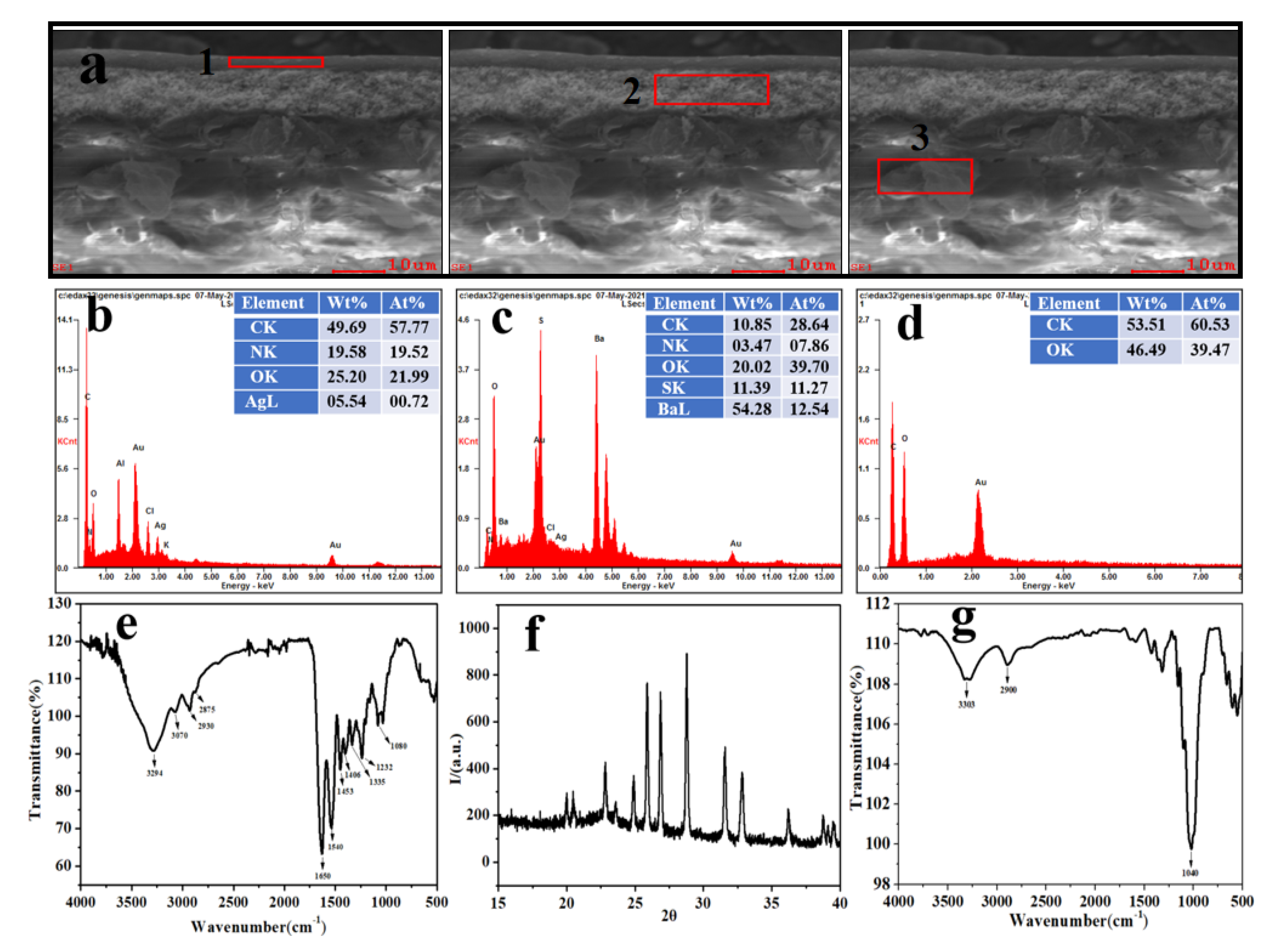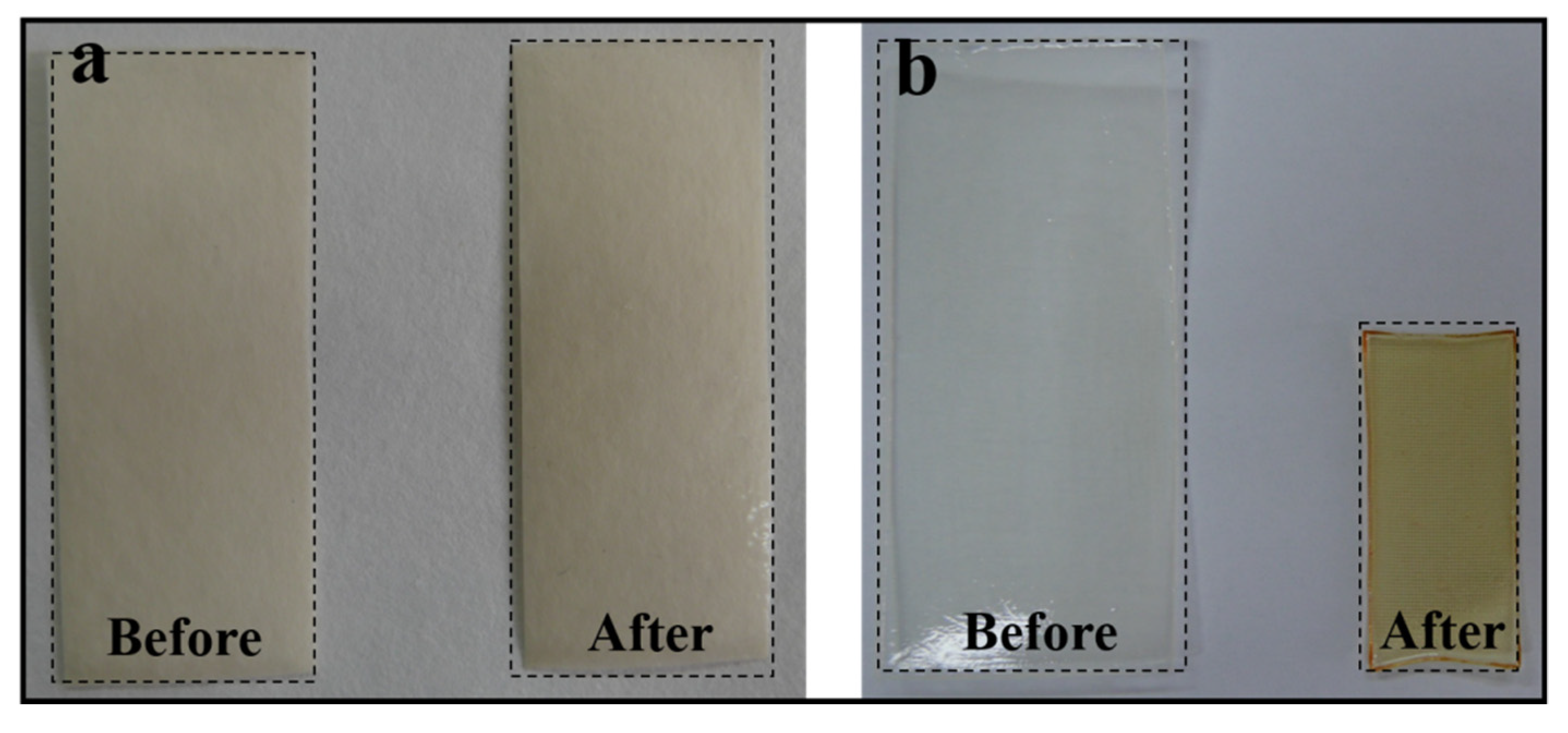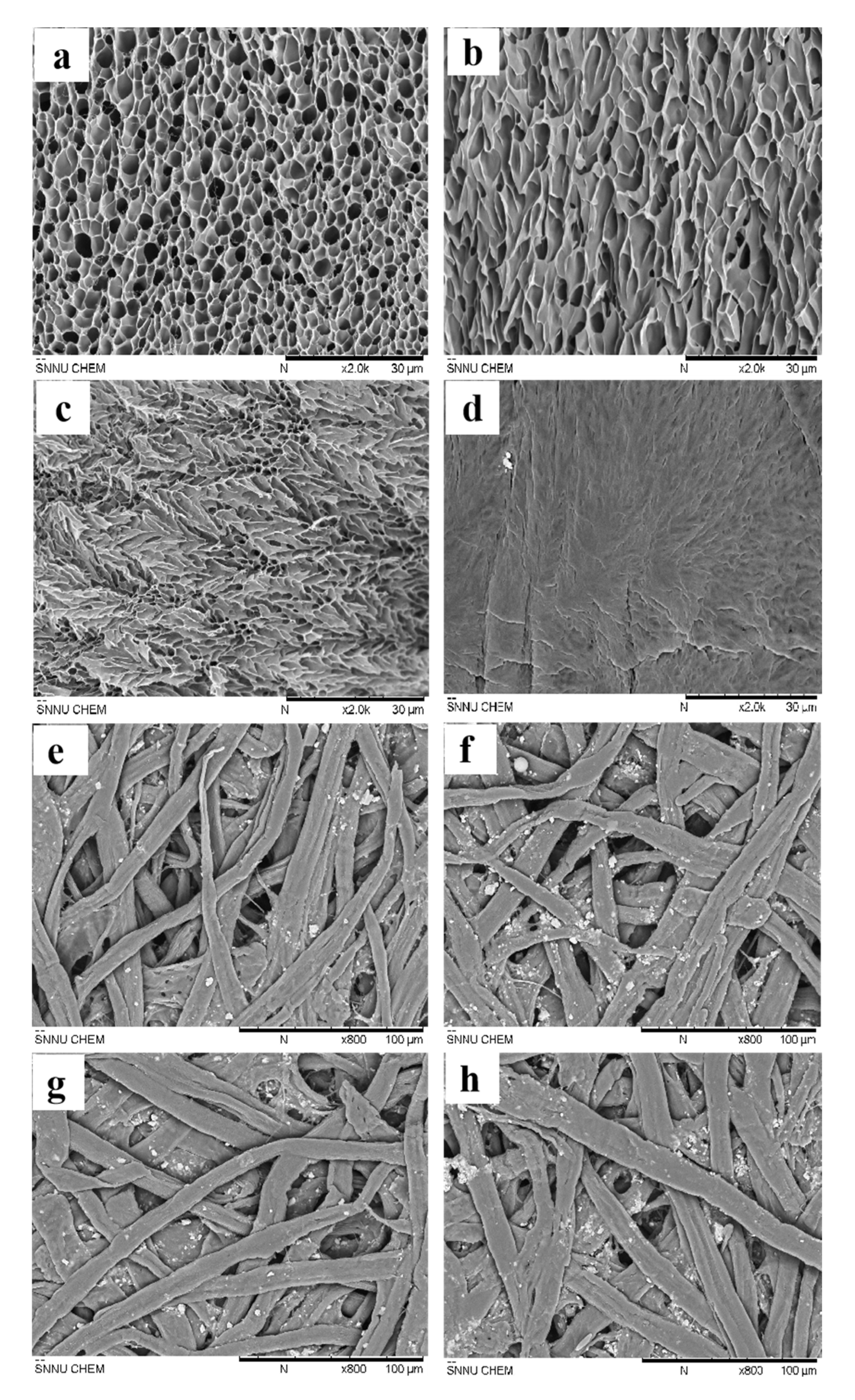An Essential Role of Gelatin in the Formation Process of Curling in Long Historical Photos
Abstract
1. Introduction
2. Experimental Section
2.1. Characterization of the Structural Composition of Photos
- (1)
- SEM-EDS: A sample (5 × 5 mm2) that contained no information was chosen at the edge of the photo relics and placed on double-sided sticky tape on an aluminum SEM specimen holder. The surface of the sample was sprayed with gold 80s by an ion sputtering apparatus (SCD005, Baltek, Liechtenstein, Germany). The sample was examined using SEM (Quanta 200, FEI, Columbus, OH, USA). Analyses were performed at a high vacuum with an accelerating voltage of 20 kV. Elemental spectrums were generated with a Quanta 200 SEM. Magnification was 4000×.
- (2)
- FT-IR spectroscopy: Fourier transform infrared (FT-IR) coupled with a diamond ATR method was used in the reflection mode to analyze the composition of the samples at room temperature and ambient humidity. FT-IR (Vertex 70, Bruker, Karlsruhe, Germany) analysis of each layer was conducted using PerkinElmer Spectrum Two in the range between 4000 and 500 cm−1 with a resolution of 4 cm−1, and the scan number was 40 times. In order to reduce the effect of carbon dioxide and water vapor on FT-IR spectra, the sample spectra have removed the background contributions.
- (3)
- XRD: The sample was a small piece of the surface of a paper base after the gelatin emulsion layer had fallen off (about 5 × 5 mm2). XRD (Smart Lab, Rigaku Corporation, Japan) was used to test the crystalline structure of the sample from the photo relics. Test condition: The X-ray intensity was 45 kV/200 mA, scanning speed was 5°/min, and scanning range was 15–40°.
2.2. Preparation of Simulated Photographic Paper Samples
2.3. Micromorphological Characterization of Gelatin Films and Paper Base Layers
3. Results and Discussion
3.1. Structures and Composition of Long Historical Photo
3.2. Macroscopic Effects of Damp-Heat Factors on Curling and Contraction in Simulated Photographic Paper Samples
3.2.1. Effects of Damp-Heat Factors on Curling Changes in Simulated Photographic Paper Samples
3.2.2. Effects of Damp-Heat Factors on Contraction Rates of Paper Base Layers and Self-Supported Gelatin Films
3.2.3. Effects of Damp-Heat Cycles on the Contraction Rate of Self-Supported Gelatin Films
3.3. Effects of Damp-Heat Factors on the Micromorphology of Curled Samples
3.4. Formation Cause of Photo Curling
4. Conclusions
Author Contributions
Funding
Institutional Review Board Statement
Informed Consent Statement
Data Availability Statement
Acknowledgments
Conflicts of Interest
References
- Tait, R.; Lobon, M.G. The conservation treatment and visual reintegration of a major repair of a painted portrait photograph of the Reverend William Henry Browne. AICCM Bull. 2016, 37, 87–95. [Google Scholar] [CrossRef]
- Abas, F.S.; Martinez, K. Craquelure analysis for content-based retrieval. In Proceedings of the 2002 14th International Conference on Digital Signal Processing Proceedings (DSP 2002), Santorini, Greece, 1–3 July 2002; IEEE: Piscataway Township, NJ, USA, 2002; pp. 111–114. [Google Scholar]
- Ruzic, T. Context aware image inpainting with application to virtual restoration of old paintings. In Proceedings of the IEICE Proceedings Series, Tokyo, Japan, 20 July 2013; Volume 16, p. ENG-2. [Google Scholar]
- Cornelis, B.; Ružić, T.; Gezels, E.; Dooms, A.; Pižurica, A.; Platiša, L.; Cornelis, J.; Martens, M.; De Mey, M.; Daubechies, I. Crack detection and inpainting for virtual restoration of paintings: The case of the Ghent Altarpiece. Signal Process. 2013, 93, 605–619. [Google Scholar] [CrossRef]
- Stanco, F.; Tenze, L.; Ramponi, G. Virtual restoration of vintage photographic prints affected by foxing and water blotches. J. Electron. Imaging 2004, 14, 043008. [Google Scholar] [CrossRef]
- Bruni, V.; Crawford, A.; Kokaram, A.; Vitulano, D. Semi-transparent blotches removal from sepia images exploiting visibility laws. Signal Image Video Process. 2013, 7, 11–26. [Google Scholar] [CrossRef]
- Ramponi, G.; Bruni, V. Virtual restoration of faded photographic prints. In Proceedings of the 2006 14th European Signal Processing Conference, Pisa, Italy, 4–8 September 2006; IEEE: Piscataway Township, NJ, USA, 2006; pp. 1–5. [Google Scholar]
- Ahmed, A.M.T. Color restoration techniques for faded colors of old photos, printings and paintings. In Proceedings of the 2009 IEEE International Conference on Electro/Information Technology, Windsor, ON, Canada, 7–9 June 2009; IEEE: Piscataway Township, NJ, USA, 2009; pp. 151–156. [Google Scholar]
- Ardizzone, E.; Dindo, H.; Mazzola, G. Multidirectional scratch detection and restoration in digitized old images. EURASIP J. Image Video Process. 2010, 2010, 680429. [Google Scholar] [CrossRef][Green Version]
- Lee, S.; Yoon, G.H. Moisture transport in paper passing through the fuser nip of a laser printer. Cellulose 2017, 24, 3489–3501. [Google Scholar] [CrossRef]
- Bedane, A.H.; Xiao, H.; Eić, M. Water vapor adsorption equilibria and mass transport in unmodified and modified cellulose fiber-based materials. Adsorption 2014, 20, 863–874. [Google Scholar] [CrossRef]
- Lipponen, P.; Leppänen, T.; Kouko, J.; Hämäläinen, J. Elasto-plastic approach for paper cockling phenomenon: On the importance of moisture gradient. Int. J. Solids Struct. 2008, 45, 3596–3609. [Google Scholar] [CrossRef]
- Dano, M.L.; Bourque, J.P. Deformation behavior of paper and board subjected to moisture diffusion. Int. J. Solids Struct. 2009, 46, 1305–1316. [Google Scholar] [CrossRef]
- Larsson, P.A.; Wågberg, L. Diffusion-induced dimensional changes in papers and fibrillar films: Influence of hydrophobicity and fibre-wall cross-linking. Cellulose 2010, 17, 891–901. [Google Scholar] [CrossRef]
- Gupta, H.; Chatterjee, S.G. Parallel diffusion of moisture in paper. Part 1: Steady-state conditions. Ind. Eng. Chem. Res. 2003, 42, 6582–6592. [Google Scholar] [CrossRef]
- Yoon, G.H.; Yoo, B.; Kim, W.K.; Woo, J.; Kim, T.; Lee, S. Multiphysics simulation of paper curl due to moisture transport. J. Mech. Sci. Technol. 2020, 34, 2075–2083. [Google Scholar] [CrossRef]
- Lindner, M. Factors affecting the hygroexpansion of paper. J. Mater. Sci. 2018, 53, 1–26. [Google Scholar] [CrossRef]
- Gimat, A.; Michelin, A.; Belhadj, O.; Pellizzi, E.; Massiani, P.; Rouchon, V. Paper sizing with gelatine: From the macro-to the nano-scale. Cellulose 2021, 28, 1–14. [Google Scholar] [CrossRef]
- McCormick-Goodhart, M.H. The allowable temperature and relative humidity range for the safe use and storage of photographic materials. J. Soc. Arch. 1996, 17, 7–21. [Google Scholar] [CrossRef]
- Dewitz, L.; Kröber, C.; Messemer, H.; Maiwald, F.; Münster, S.; Bruschke, J.; Niebling, F. Historical Photos and Visualizations: Potential for Research. Int. Arch. Photogramm. Remote. Sens. Spat. Inf. Sci. 2019, XLII-2W15, 405–412. [Google Scholar] [CrossRef]
- Ardizzone, E.; Dindo, H.; Mazzola, G. A knowledge based architecture for the virtual restoration of ancient photos. Pattern Recognit. 2018, 74, 326–339. [Google Scholar] [CrossRef]
- Hedjam, R.; Cheriet, M. Historical document image restoration using multispectral imaging system. Pattern Recognit. 2013, 46, 2297–2312. [Google Scholar] [CrossRef]
- Zhang, L.; Yip, A.M.; Brown, M.S.; Tan, C.L. A unified framework for document restoration using inpainting and shape-from-shading. Pattern Recognit. 2009, 42, 2961–2978. [Google Scholar] [CrossRef]
- Wan, Z.; Zhang, B.; Chen, D.; Zhang, P.; Chen, D.; Liao, J.; Wen, F. Bringing old photos back to life. In Proceedings of the IEEE/CVF Conference on Computer Vision and Pattern Recognition, Seattle, WA, USA, 13–19 June 2020; pp. 2747–2757. [Google Scholar]
- Li, Y.H.; Zhou, Y.J.; Jia, Z.H.; Liu, J.J. Research on key technology for the restoration and protection of photosensitive image archives. China Arch. 2018, 4, 66–67. (In Chinese) [Google Scholar]
- Liu, H.F.; Li, Y.H. Research on enhancement of blurred and diluted black&white photos. Arch. Sci. Study 2006, 1, 46–49. (In Chinese) [Google Scholar]
- Li, Y.H.; Zhao, Y.H. An Enhancement and Presentation Reagent for the Black&white Photos. Chinese Patent CN102786847A, 21 November 2012. [Google Scholar]
- Liu, H.F. Study on the Enhancement Reagent of Blurred, Diluted and Mildew Black&white Photos; Shaanxi Normal University: Xi’an, China, 2006. (In Chinese) [Google Scholar]
- Wang, Z.Y. Comparative Study on the Protective Effect of Plastic Paper and Carbon Paper on the Black&white Photos; Shaanxi Normal University: Xi’an, China, 2015. (In Chinese) [Google Scholar]
- Kataoka, Y.; Kitadai, N.; Hisatomi, O.; Nakashima, S. Nature of hydrogen bonding of water molecules in aqueous solutions of glycerol by attenuated total reflection (ATR) infrared spectroscopy. Appl. Spectrosc. 2011, 65, 436–441. [Google Scholar] [CrossRef] [PubMed]
- Fabian, H.; Naumann, D. Millisecond-to-Minute Protein Folding/Misfolding Events Monitored by FTIR Spectroscopy. In Protein Folding and Misfolding; Springer: Berlin/Heidelberg, Germany, 2012; pp. 53–89. ISBN 978-3-642-22230-6. [Google Scholar]
- Siebert, F.; Hildebrandt, P. Vibrational Spectroscopy in Life Science; John Wiley&Sons: Weinheim, Germany, 2008; p. 156. ISBN 978-3-527-40506-0. [Google Scholar]
- Wu, W. Effect of gelatin additive on microstructure and composition of electrodeposited rhenium–nickel alloys in aqueous solutions. Appl. Phys. A 2016, 122, 1028. [Google Scholar] [CrossRef]
- Ebrahimi, S.; Fathi, M.; Kadivar, M. Production and characterization of chitosan-gelatin nanofibers by nozzle-less electrospinning and their application to enhance edible film’s properties. Food Packag. Shelf 2019, 22, 100387. [Google Scholar] [CrossRef]
- Guo, J.; Li, X.; Mu, C.; Zhang, H.; Qin, P.; Li, D. Freezing–thawing effects on the properties of dialdehyde carboxymethyl cellulose crosslinked gelatin-MMT composite films. Food Hydrocoll. 2013, 33, 273–279. [Google Scholar] [CrossRef]







Publisher’s Note: MDPI stays neutral with regard to jurisdictional claims in published maps and institutional affiliations. |
© 2021 by the authors. Licensee MDPI, Basel, Switzerland. This article is an open access article distributed under the terms and conditions of the Creative Commons Attribution (CC BY) license (https://creativecommons.org/licenses/by/4.0/).
Share and Cite
Liu, J.; Li, Y.; Hu, D.; Chao, X.; Zhou, Y.; Wang, J. An Essential Role of Gelatin in the Formation Process of Curling in Long Historical Photos. Polymers 2021, 13, 3894. https://doi.org/10.3390/polym13223894
Liu J, Li Y, Hu D, Chao X, Zhou Y, Wang J. An Essential Role of Gelatin in the Formation Process of Curling in Long Historical Photos. Polymers. 2021; 13(22):3894. https://doi.org/10.3390/polym13223894
Chicago/Turabian StyleLiu, Jiaojiao, Yuhu Li, Daodao Hu, Xiaolian Chao, Yajun Zhou, and Juanli Wang. 2021. "An Essential Role of Gelatin in the Formation Process of Curling in Long Historical Photos" Polymers 13, no. 22: 3894. https://doi.org/10.3390/polym13223894
APA StyleLiu, J., Li, Y., Hu, D., Chao, X., Zhou, Y., & Wang, J. (2021). An Essential Role of Gelatin in the Formation Process of Curling in Long Historical Photos. Polymers, 13(22), 3894. https://doi.org/10.3390/polym13223894





